://offlowers.blogspot.com
Toyota Off Road
Poppy Flower
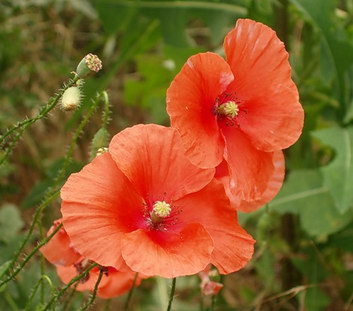
Some poppies grow wild in almost every country in the north temperate zone. Several kinds are raised in gardens for their large, many-tinted flowers.Oriental poppies, natives of the Mediterranean region, have the largest flowers, often six to eight inches across, white to red in color. Iceland poppies, from arctic regions, have small, fragrant flowers of different delicate colors. Alpine poppies are low-growing rock garden Perennials with sweet-scented yellow or white flowers. The popular, many-colored Shirley Poppies are cultivated forms of the corn, or Flanders poppy, a common wild flower of Europe and Asia. They are annuals.The opium poppy, with gray-green leaves and white to purple flowers, is sometimes grown in gardens. It is widely cultivated in eastern countries for opium, made from the juice oi its unripe seed pods. The ripe seeds are used in baking. Growing the plant is illegal in the United States. (See Opium.)The plume poppy, native in eastern Asia, is a tall, bushy plant with bluish-gray leaves, topped by a showy cluster of white flowers. The California poppy, with satiny, creamy to bright orange flowers, grows wild in western United States. Cultivated varieties may have single or double flowers, some in shades of red. Prickly poppies are natives of the warm, dry parts of the United States. They have white, yellow, or purplish poppylike flowers and thistlelike leaves. They become weeds in some places.Poppies grow best in sunny places. Most kinds do well in ordinary garden soil. Seeds should be planted in the fall or in very early spring. Some poppies self-sow. Oriental poppies, true perennials, are grown from seed or from root-cuttings. Iceland and California poppies are perennials that bloom in their first season if the seeds are planted early.
LILY
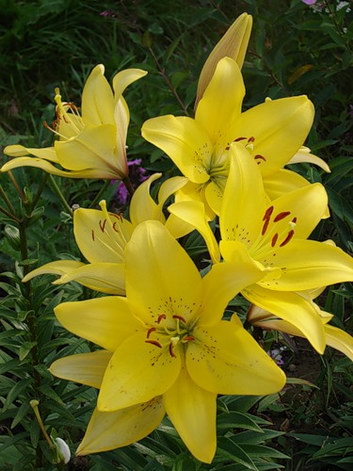
LILY. The white lily stands for purity. Artists for centuries have pictured the angel Gabriel coming to the Virgin Mary with a spray of lilies in his hand, to she is to be the mother of the TURK'S-aPLY.LILY is the family name of about 2,000 species of plants. Most are herbs (plants without woody stems). The family includes onion, asparagus, tulip, and hyacinth. The name comes from a group of perennials of the genus Lilium, often called the true lilies. Of the 80 or 90 species known, about 24 are natives of North America, about 50 are Asian, and 12 are European. True lilies have underground bulbs made of overlapping scales which contain stored food. Their flowers (except for rare double forms) have three sepals and three petals so nearly alike that all six often are called petals. The blossoms grow at the top of a leafy stalk. They are of many colors and shapes. Amongthe most beautiful are the white Madonna (Easter) lily the Japanese Turk's-cap with orange flowers spotted with red; the clustered dark-orange, purplish-spotted tiger lily; the scarlet coral lily; the gold-banded lily of Japan; and the pink Speciosum lily.Lilies (chiefly lily bulbs) have served as human food in many countries. The ancient Greeks and Romans used some kinds in making certain salves and ointments. Lilies appeared as pottery decorations, in paintings, and in other forms of art hundreds of years ago. Species from many lands are cultivated in a number of countries, especially in Europe. From them, plant growers have developed popular hybrids and varieties of many colors and shapes, suited to different climates and uses. In most of the United States lilies bloom in almost every color (except blue). They can be grown from early summer to frost. Some kinds are grown as house plants. Many are raised each year in commercial greenhouses, especially for Easter. To supply gardeners and other growers, thousands of different kinds of lily bulbs are raised in the United States, Japan, Bermuda, and many parts of Europe. New bulbs may be produced In several ways: (1) By natural division of older bulbs.(2) By small bulblets produced underground above or around the bulb. (3) By aerial bulblets that grow in the leaf-axils of some species (4) By seeds, and from scales taken from bulbs. The word ily is included in the common name of many plants that are not true lilies. Among these are day lilies, plantain-lilies, Mari-posa-lilies, and trout-lilies or dogtooth violets. All of these are in the lily family but not of the genus Lilium. Others are calla lilies, in the same family as Jack-in-the-pulpit; belladonna lilies, of the Amaryllis family; and water lilies.

Rose of Sharon, also called Althaea, is a large hibis-cus shrub with lovely rose, purple, white, or blue flowers about 3 inches (8 centimeters) wide. The flowers bloom frommidsummer to early fall. The rose of Sharo grows about 12 feet (3.7 meters) high and has large, three-lobed leaves. It is hardy and does well under unfa-vorable conditions/ either in the city or in the country.It is native to Eastern Asia and grows in many North American gardens. Gardeners havedeveloped several forms of the shrub. The rose of Sharon may be grown in pots and later transplanted outdoors. Scientific classification. The rose of Sharon is in the mal-low family, Malvaceae. Its scientific name is Hibiscus syriacus.
Acacia
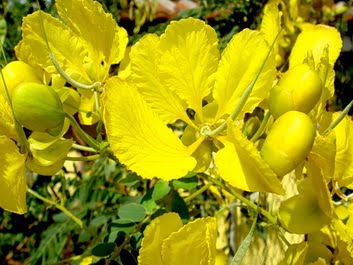
ACACIA (a-ka'sha). About 1200 species of acacia are scattered through the warm regions of the world. Most of them are shrubs or small trees. Some are matted plants a few inches high. All are thorny and pod-bearing. The tiny sweet-smelling blossoms cluster together in fluffy balls or cylinder shapes. They range in color from deep yellow to almost white. The leaves are usually grayish and fernlike. The acacia is quick-growing and short-lived.Australia has about 300 species of acacia. The early settlers called them wattles because they used the pliant branches to make wattle-and-daub huts. The golden wattle is Australinational Bower.a's
Baby's-breath
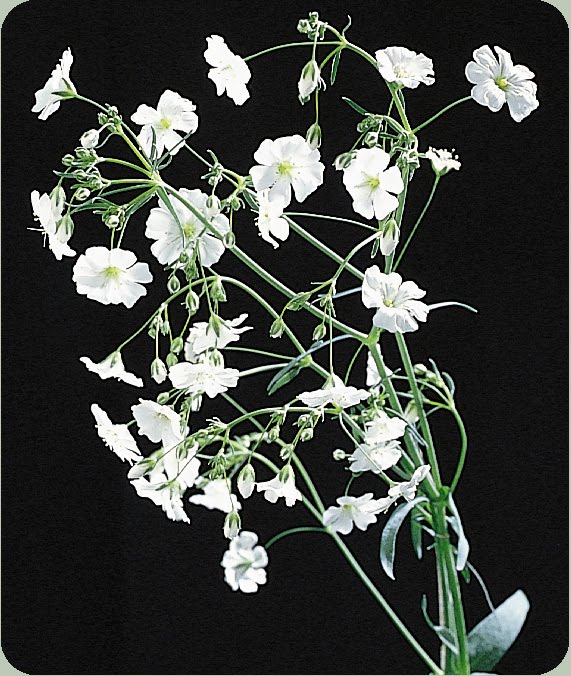
Baby's-breath ,this is also spelled babies'-breath, is a garden plant grown for its many tiny white flowers. The plants are from 2 to 3 feet (60 to 92 centimeters) tall, and havewidely branching stems. They are grown in front of shrubbery in rock gardens. Florists mix baby's-breath among the larger flowers in bouquets for a delicate effect. The most common type of baby’s-breath is a perennialwhich lives from year to year. However, a few related plants often called baby's-breath are annuals, and are grown from seeds each year. These plants have rose or pink flowers. Baby's-breath is easy to grow. It is often found in dry, open places. See also PinkScientific classification. Baby's-breath belongs to the pink family, Caryophyllaceae. The scientific name for the perennial baby’s-breath is Gypsophila panicula..
Calla
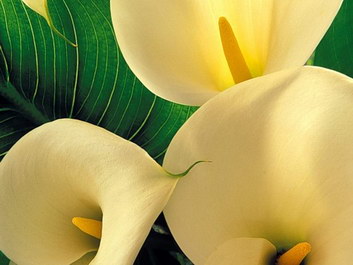
CALLA (kal'a), or calla lily, is a beautiful garden flower of the arum family, or Ara-ceae. It is related to the jack-in-the-pulpit and the skunk cabbage. What looksthe flower of the calla is really a leaflike sheath called a spathe. The true flowers are very small and are inside the spathe. In the common calla the spathe is pure white. There are also yellow and pink varieties. likeThe calla grows from a bulb. This bulb must be planted in rich well-watered soil. Often it is placed in loam or soil mixed with manure. In most parts of North America it is grown indoors or in a greenhouse.In California and southern Texas it can be grown outdoors and is planted in parks in great flower beds. The much smaller marsh calla grows wild in swamps in the northern temper-zone.The most common tropical calla comes from the banks of the Nile River in Egypt It is called calla lily, Ethiopian lily, or common calla. The plant has a 10-inch (25-centimeter) white leaf. The calla lily causes a burning irritation to Ihe mouth and stomach if eaten.Scientific classification. The calla is in the arum family. Ar-aceae. The common calla is Zantedeschia aethioplca. The water arum is Calla palustris.
CROCUS

CROCUS, flowering plants that bloom in the spring or in the fall. They belong to the iris family. Their original home was in the warmer parts of Europe and Asia, but now they are grown in gardens in many lands.Crocuses grow from a solid bulblike stem called a corm. The corm is an underground stem where food is stored.The flowers of the crocus are white, lilac, purple, or yellow Some of them have a very pleasant odor. Each flower has three petals, three sepals, three stamens, and a three-parted pistil. The sepals and petals form a long tube. The ovary where the seeds develop is at the bottom of the tube. When the seeds are nearly ripe, the stem lifts the pod aboveground. The ripe pod splits and scatters the seeds.Slender, grasslike leaves grow soon after the spring crocus has stopped blooming. Leaves of some fall-blooming crocuses appear the following spring. Others bear leaves and flowers together. Crocus leaves should not be cut until they die naturally so that more food can be made and stored in the corm.Corms of spring-blooming crocus should be planted in September and October, those of autumn-blooming types in August. They should be planted three to four inches deep, in well-drained soil. New plants may grow from seed. Usually, however, they are raised from small corms that develop from the older corms. Crocuses may grow and bloom for years in the same place without replanting.
Rhododendron
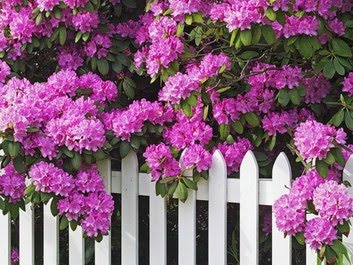
RHODODENDRON. Throughout June and July the colorful flowers and shining foliage of the rhododendron beautify the mountain slopes of North Amer-ica. The flowers are pink, rose, lilac, or purple. The species usually found in the East is the American, or greatrhododendron. The Carolina, or Catawba, rhododendron grows in the high Appalachians. A species called coast rhododendron is found on the Pa-cific coast (for picture in color, see Flowers, Wild Flowers).Other species flourish in Europe and Asia, especially in the Himalayas, Borneo, and Java. Some treelike species are 40 to 60 feet high. Shrub forms may reach a height of 20 feet. Most species of rhododen-dron are evergreen. Rhododendrons are cultivated widely as garden shrubs. Many hybrid or grafted rhododendrons de-velop more beautiful flowers than do native species. The plants flourish in moist but well-drained peaty soil. Rhododendrons belong to the heath family and are related to the azaleas. Because they contain a resinoid called andromedotoxin they are poisonous.The flowers of the great rhododendron, often called the rosebay rhododendron, grow in clusters from a conelike bud. They vary in color from rose-pink to white except at the throat, where they are greenish, spotted with yellow and orange. The dark-green leaves are lance-shaped and evergreen, drooping in winter. The scientific name of the great rbodo-dendron is Rhododendron maximum; of the Catawba species, R. catawbiense; and of the coast rhododen-dron, R. macrophyllum.,